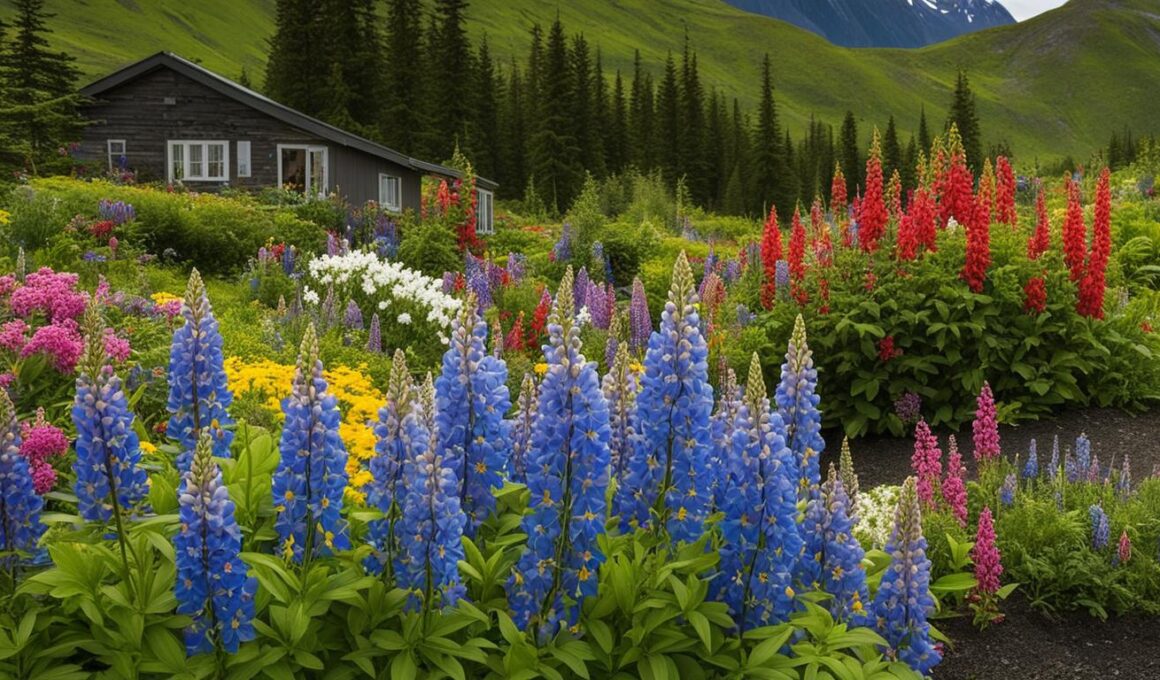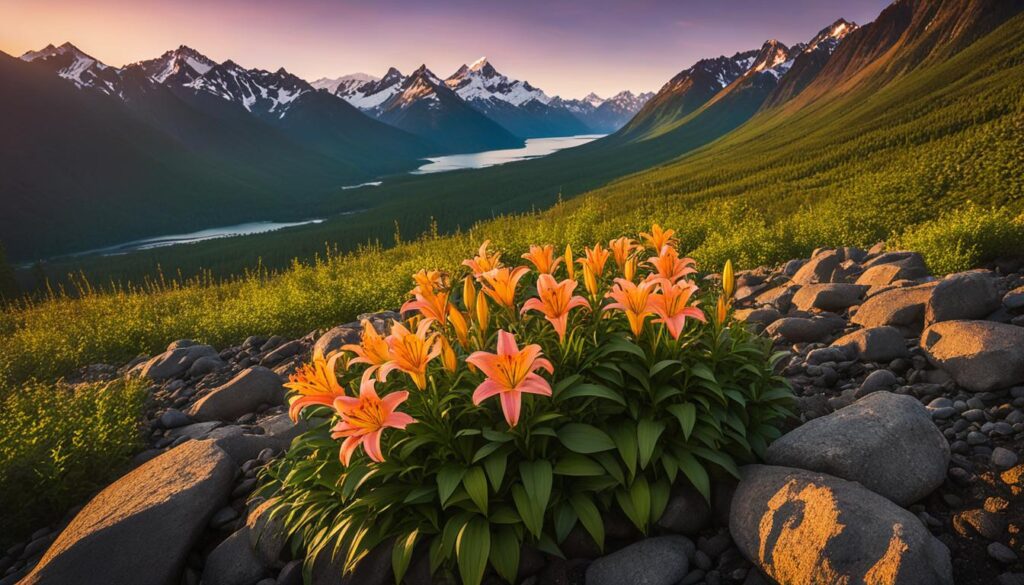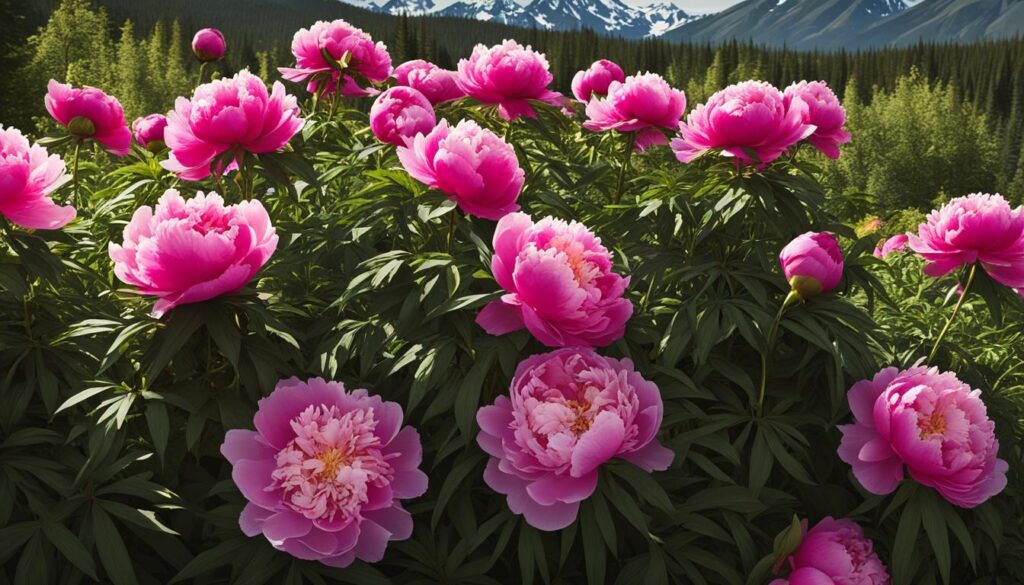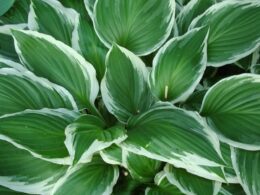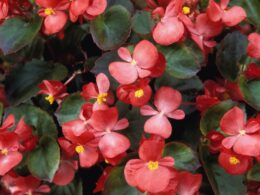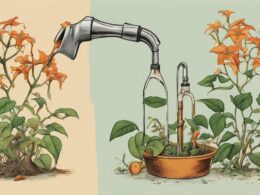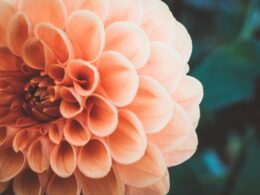Embarking on the journey of Alaska gardening introduces you to a world where the robust beauty of cold climate flowers defies the chills of the Northern frontier. While this vast and diverse landscape may present its set of challenges, it’s equally ripe with opportunity for those passionate about cultivating hardy perennials. Whether you’re a novice gardener or a seasoned green thumb, transforming your Alaskan outdoor space into a vibrant showcase of flora is not just possible—it’s a deeply rewarding experience.
As you gear up to adorn your garden with the best that nature offers, remember, Northern frontier gardening is about more than just weathering the cold; it’s about thriving in it. The key is choosing varieties that not only survive but also flourish under the Alaskan sky. To assist you in this green quest, we’ve curated a list of blooms that promise to enliven your garden with their resilience and charm.
Acclimating to Alaska’s Unique Growing Conditions
When you think of Alaska, what comes to mind may be its icy landscapes and the majestic beauty of its wilderness. However, Alaska is also home to a dynamic growing season that, with a keen understanding of its idiosyncrasies, can yield a lush and vibrant garden. To turn this vision into reality, you must begin by acquainting yourself with the state’s hardiness zones, optimizing sun exposure, and meticulously preparing the soil to nurture your chosen flora.
Understanding Alaska’s Hardiness Zones
As an Alaskan gardener, your first step toward a thriving garden is to familiarize yourself with the Alaska hardiness zones. These zones guide you through the selection of plants that are best suited for your local climate conditions. Knowing the specific zone of your garden will help you choose the plants that are most likely to succeed, as these zones reflect the average minimum temperatures of the area.
Maximizing Sun Exposure in Northern Climates
The peculiarities of the northern climes mean that your garden will experience a unique pattern of sun exposure throughout the growing season. During the height of summer, you’ll witness nearly endless daylight, a phenomenon that prompts plants to grow at an accelerated rate. Capitalize on this by strategically positioning your garden to gain maximum sun exposure. This ensures your plants have the energy they need to bloom vibrantly and healthily.
Soil Amendments for Successful Alaskan Flora
Soil quality in Alaska can vary dramatically, and investing time in soil preparation can make all the difference. Amend your soil with organic matter to improve drainage and nutrient content—critical steps in ensuring the hardiness of your plants. Consider adding compost to enhance the soil’s fertility, and if necessary, use raised beds to better control the soil environment. This vigilant preparation will lay a solid foundation for your treasured garden to flourish against the Backdrop of the Last Frontier.
Garden Lilies: A Display of Summer Elegance in Alaska
As summer greets Alaskan gardens, it brings with it the unparalleled elegance of garden lilies. These hardy yet delicate flowers offer a refined touch, creating displays that can outshine the season’s extended daylight. Your garden, whether in the shadow of the mountains or basking in the vast open expanses, becomes a canvas for these summer blooms.
To cultivate elegant flowers that stand tall and proud against Alaska’s majestic backdrop, garden lilies are an incomparable choice. There’s a reason they’re cherished: these perennials carry a stately presence and a fragrance that can sweeten the crisp northern air, making them a beloved centerpiece in any Alaskan garden.
- Select the Right Varieties: Opt for garden lilies that are known for their resilience. Asiatic, Martagon, and Trumpet lilies, among others, are well-adapted to Alaskan climates.
- Planting Location: Choose a spot in your garden that receives ample sunlight to encourage a bountiful bloom.
- Soil Considerations: Prioritize well-draining soil, enriching it with organic matter to provide the nutrients these elegant blooms crave.
- Maintenance: Mulch the base to retain moisture and protect the roots from temperature swings that can accompany Alaskan summers.
- Pest and Disease Vigilance: Keep an eye out for common lily afflictions, such as the lily beetle, and treat promptly to maintain the health and vibrancy of your blooms.
Embrace the beauty that summer blooms bring to your Alaskan retreat. Garden lilies, with their striking colors and stately form, are not only capable of withstanding the unique environmental pressures but will also provide enchanting curb appeal to your home.
Peonies: Alaska’s Large and Luscious Blooms
As a beacon of grandeur in the seemingly unforgiving climate of the north, Alaska peonies captivate gardeners with their lush flowers and remarkable cold-resistant properties. Thriving where other blooms may shy away, these hardy perennials have earned their place as a favorite in the Alaskan garden. Let’s delve into the tenacity of these luxurious flowers and explore the essentials of Alaskan peony care.
The Resilience of Peonies in Cold Climates
In the land of the midnight sun, peonies have proven their resilience time and time again. Their ability to withstand colder temperatures not only makes them a perfect fit for your Alaskan oasis but also ensures a showcase of generous blooms that add opulence to your outdoor space. Embracing the chill, these florals come to life against the crisp air, their full and flamboyant blossoms bursting forth in an array of colors that stand in defiance of the harsh landscape.
Peony Care and Maintenance for Alaskan Gardeners
To maximize the potential of your lush flowers, it’s imperative to provide meticulous care tailored to the unique Alaskan environment. Below are a few tips to ensure your peonies bloom with vigour:
- Soil Preparation: Begin with rich, well-draining soil augmented with organic matter. Peonies thrive in nutritive substrates that cater to their feeding needs.
- Planting Depth: Ensure the eyes of the peonies – or the growth nodes – are no deeper than two inches below the soil surface, which encourages optimal growth.
- Water Wisely: Over-watering can lead to problems with root rot, especially in colder climates. Water your peonies adequately, allowing the soil to dry slightly between watering sessions.
- Winter Care: In the fall, add a layer of mulch to protect the roots from fluctuating winter temperatures, then remove it as the ground thaws to prevent rot.
- Sunlight Exposure: Peonies cherish the sun. Plant them in a location where they will receive full sunlight, ensuring their showy display is as grand as it can be.
With these care guidelines in hand, you are poised to foster a garden graced by the splendour of Alaska peonies, transforming your space into a lush sanctuary where these hardy treasures can flourish.
Best Flowers To Plant In Alaska
Creating a garden in Alaska that exudes lasting beauty comes down to selecting the right perennials in Alaska. These stalwart plants provide your garden with enduring charm and long-lasting blooms, year after year, despite the challenges of the northern climate. For the Alaskan gardener, your pursuit of color doesn’t have to end with the brief summer. There’s a wealth of suitable perennials that will stand tall against the frost and add life to your beds with minimal yearly upkeep.
Selecting the Right Perennials for Lasting Beauty
When curating your northern botanical oasis, it’s essential to focus on perennials that can withstand the frigid winters and blossom anew each spring. Plants like the resilient delphinium, the vibrant lupine, and the hardy hosta have all proven to be reliable perennial choices that will not only endure but also thrive, bringing a delightful variety of hues and textures to your Alaskan landscape.
Top Primrose Varieties for Early Spring Color
Nothing signals the reawakening of your garden quite like the vivid display of early spring flowers. Primroses, with their kaleidoscope of colors, are a matchless choice for delivering an initial burst of life after the long winter. With several varieties, from the Pacific hybrids to the quaint native species, primroses start their showy performance in early spring, setting the stage for the blooming season ahead. Opt for primrose selections like the ‘June Bride’ or the ‘Alaska Hardy’, whose blooms can cheerfully greet you even when the last remnants of snow cling to the ground.
- Choosing the Right Spot: Plant your primroses where they can bask in the gentle sun of the Alaskan spring, but remember to give them some shade, as too much of the midday sun in the peak of summer can be as detrimental as the winter’s cold.
- Soil and Water Needs: These early spring diplomats prefer moist, well-draining soil rich in organic matter, ensuring they have the nutrients they need to provide the first flush of the season’s color.
- Primrose Care: With minimal care, these robust little plants can become self-seeding, giving you an ever-expanding palette of color to enjoy as the seasons go on.
Investing in these primrose varieties and suitable perennial selections paves the way for a garden that remains vivacious and splendid, year after year, in the heart of Alaska. Take the time to choose wisely, and witness how your garden transforms into an Alaskan paradise, resplendent with life and color.
Color and Fragrance: Choosing Hardy Roses and Shrubs
In the striking yet demanding climate of Alaska, the addition of hardy roses and fragrant shrubs to your garden design can make the world of difference. Introducing these resilient plant varieties not merely ensures a garden that can withstand the harsh winters but also turns your space into an aromatic haven awash with colors. Let’s uncover the secrets to realizing a garden teeming with vibrancy and a hint of the wild Alaskan essence.
Incorporating Hardy Shrub Roses into Your Garden Design
As you ponder on creating your personal garden sanctuary, Hardy roses Alaska-friendly varieties such as the Rugosa Rose or the beautiful ‘Explorer’ series are indispensable. These roses are celebrated not only for their beauty but their tenacious nature, triumphing over the chill to bloom spectacularly within your green space.
- Choosing the Right Species: Select roses renowned for their robustness in colder regions, ensuring they will not just survive, but thrive.
- Planting Location: Find a spot that soaks up the sun and shields your roses from harsh winds, a sunny nook in your garden is ideal.
- Soil and Maintenance: Fertilize with lover’s care, opting for well-draining soil, and stay vigilant for signs of disease or pests.
Ornamental Trees That Flourish in The Last Frontier
Ornamental trees, with their sculptural forms, can act as the cornerstone of your Alaskan garden landscape. When paired with the aforementioned shrubs, these trees offer structural diversity and year-round interest. Varieties such as the Siberian Pea Tree or the hearty Mountain Ash fit beautifully within the Alaskan tapestry.
- Resilient Selections: Focus on species that have demonstrated adaptability to Alaska’s unique environment.
- Tree Placement: Acknowledge the tree’s mature size for optimal placement, ensuring ample growth space and the utmost visual impact.
- Long-term Thinking: Ornamental trees often require patience, but with time, they lend a stately air to your personal oasis.
Eye-Catching Arrangements with Hanging Baskets and Vines
Transform your Alaskan garden into a multi-dimensional showpiece by integrating diverse hanging baskets and climbing vines. By doing so, you create layers of intrigue that extend beyond the ground and elevate the visual appeal with stunning Alaskan blooming arrangements. Let’s explore how to achieve vertical splendor in your garden.
Utilizing Hanging Baskets: There is something undeniably charming about a cascade of blooms spilling from a hanging basket. It’s a wonderful strategy to amplify space and add a flourish of color at eye level. For optimal impact, consider baskets filled with vibrant petunias, lush ferns, or the beguiling fuchsia – each a perfect match for the cooler Alaskan climate. Keep your baskets thriving with regular watering and fertilization, thus ensuring a season-long display of flora.
Embracing the Vertical: With climbing vines, you invite the eye to roam upwards, taking in the full extent of your garden’s splendor. Varieties such as clematis and honeysuckle are not only climbers but are also known for their hardiness and fragrant flowers, which mesh seamlessly with the rustic Alaskan backdrop. Providing sturdy trellises or arches for the vines will grant them the support they need to flourish.
- Selection: Choose hanging baskets and vines that are proven to withstand cooler temperatures and still bloom with gusto.
- Positioning: Place your hanging baskets in spots where they can receive adequate sunlight yet remain protected from harsh winds.
- Care: Regular pruning will encourage growth and shape your vines while maintaining the aesthetic you desire.
By adding these vertical elements to your garden, you craft an inviting space that showcases the beauty of Alaskan blooming arrangements, no matter the size of your terrain. Maintain them with love and attention, and watch as your garden transforms into an elevated oasis of tranquility.
Top Plants for an Unforgettable Alaskan Floral Show
To stage an unforgettable floral show in your Alaskan garden, consider the top 20 plants that harmonize resilience with splendor. This elite group embodies the tenacity requisite for Alaskan weather, while promising a tapestry of color and form. Embrace strategic gardening techniques such as innovative plant combinations that guarantee a visual festival of continuous blooms through the seasons.
Innovative Combinations to Enhance Visual Interest
Break the monotony with innovative plant combinations that intermingle various textures, heights, and colors. Start with a base of lush peonies or delphiniums, adding in quirky pops of color from clusters of aquilegia or drifts of iridescent blue poppies. Intersperse these with tufts of ornamental grasses or wild ferns to weave complexity into your Alaskan garden. By intertwining flower and foliage, you create a dynamic landscape that captivates at every glance.
- Contrast ruffled peony petals with the sleek lines of ornamental grass.
- Pair the deep blues of poppies with the sun-kissed hues of marigolds.
- Mix the majestic spikes of lupine among the delicate bells of campanula.
Curating a Continuous Bloom with Strategic Plant Choices
To achieve a garden that defies the brevity of the Alaskan summer with continuous blooms, timing and selection are key. Opt for plants with staggered blooming times such as early-spring primroses, midsummer fireweed, and late-showing goldenrod. This strategy provides a consistent display of flowers, ensuring that as one plant begins to retreat, another takes the stage. With thoughtful planning, your garden can offer an enduring spectacle of blossoms, delivering an eye-catching performance from thaw to frost.
- Map out bloom times to create a season-long flowering schedule.
- Integrate perennial bulbs such as tulips and daffodils for a radiant spring kickoff.
- Supplement with summer-blooming hardy roses to sustain the floral show.
- Include autumn champions like asters to conclude the season with vibrancy.
The reward for your efforts is more than just the blooms themselves; it’s the symphony of wildlife they attract, the aromatic delight they exude, and the pride of cultivating a breathtaking Alaskan floral show amid the wild beauty of the Last Frontier.
The Dramatic Impact of Foliage: Incorporating Leaves and Texture
The allure of a garden is not solely in its blooms. The unsung heroes, often, are the leaves that provide an undercurrent of texture in gardens. In Alaska’s unique landscape, the dramatic foliage of many plants adds depth and contrast, forging a garden that captivates with each nuanced leaf pattern. Let’s delve into the selection of foliage that can introduce a new dimension to your garden’s aesthetic, ensuring that even in bloom’s absence, your space continues to intrigue.
Utilizing Dark Foliage for Contrast in Garden Beds
In the orchestration of a garden, the role of color is vital. The deep hues of dark foliage act as the perfect foil to the brighter notes of flowering plants. Envision the rich tapestry you can create by planting specimens with dark, near-black leaves that plant contrast against lighter greens or floral colors—a visual drama unfolds, emphasizing separate elements that might otherwise go unnoticed.
- Consider adding plants like Heuchera with its dark, moody leaves to provide a captivating backdrop for brighter blooms.
- Introducing Ligularia, with its large, bronze-tinted foliage, punctuates your garden beds with bold contours.
Discovering Plants with Unique Leaf Patterns and Textures
Leaves are the constant companions to flowers, anchoring them with an array of leaf patterns that bring a tactile dimension to your beds and borders. The magic lies in the variety—from the corrugated surfaces of certain Hosta varieties to the delicate filigree of ferns. These living fabrics weave an intricate botanical quilt that pleases the eye and invigorates the senses.
- Integrate plants like the Japanese Painted Fern for its metallic silver and green fronds that gleam even in the dappled sunlight of Alaska’s wooded areas.
- Incorporate the bold stripes of a Zebra Grass to animate your space with the illusion of movement.
As you plan your Alaskan garden, remind yourself to look beyond the allure of blossoms. Dramatic foliage offers not just a visual feast but also a cooler, textured sanctuary even when the floral actors take their final bow. Your garden is a living work of art, one that you can sculpt with the lush, varied tapestry of foliage that resonates against the grandeur of the Alaskan backdrop.
Tips for Growing Fragrant Sweetpeas in the Alaskan Climate
The unparalleled charm of growing sweetpeas adds an enchanting layer of fragrant flowers to your Alaskan garden. With their sweet scent and ruffled blossoms, sweetpeas are the quintessential cottage garden plant. However, the cooler climates of Alaska call for a few strategic practices to ensure these vines thrive and fill your garden with color and fragrance. From indoor seed starting to providing sturdy climbing plants support, follow these tips to successfully grow sweetpeas in the Alaskan climate.
Starting Sweetpeas Indoors for an Abundance of Blooms
To achieve an early and abundant bloom, it’s essential to start your sweetpeas indoors. Creating the right indoor environment stimulates germination and establishes strong seedlings ready for the Alaskan summer. Here’s how to ensure your sweetpeas get off to a flourishing start:
- Favor quality sweetpea seeds renowned for their vigor and scent, ensuring a delightful floral display.
- Begin the sowing process in early spring, using deep pots or modular trays filled with potting soil.
- After sowing, maintain a consistently moist environment without overwatering, watching for sprouts to emerge within 10 to 12 days.
- Once your seedlings have several sets of leaves, pinch them back to encourage bushy growth, setting the stage for more blooms.
Starting indoors allows you to extend the blooming season, letting you savor the allure of sweetpeas from the comfort of your home before introducing them to your garden’s trellis or supports.
Effective Support Systems for Climbing Sweetpeas
Sweetpeas are natural climbers, eager to reach toward the Alaskan sky with their delicate tendrils. As your seedlings transition to outdoor life, they require appropriate support to showcase their beauty. Consider these suggestions:
- Install a sturdy trellis or wire framework as climbing plants support, ensuring it is secure against unpredictable weather.
- Tie young plants gently to the trellis at intervals to guide their ascent and produce longer, healthier stems.
- Continue to provide support throughout the growing season, allowing your sweetpeas to twine upwards and create a picturesque vertical display.
The proper support not only elevates the plants but also enhances air circulation, reducing the risk of disease and highlighting the intricate blooms against a lively green backdrop.
By embracing these tips and cultivating sweetpeas suited for the Alaskan climate, you’ll transform your space into a fragrant paradise each summer. With attention to detail and a passion for gardening, your efforts will be rewarded with an abundance of scented sweetpea flowers to enjoy both outdoors and in your home.
Maximizing Garden Health: Watering and Fertilizing in Alaska
For the diligent gardener in Alaska, achieving a lush landscape entails a nuanced approach to garden health. You’re tasked to harmonize with nature’s rhythm — adjusting watering techniques for the region’s cool temperament and selecting the right fertilization to foster robust plant growth. The bounty of your blooms hinges on these astute practices which cater to the unique climatic conditions of The Last Frontier.
Adapting Watering Techniques for Cooler Northern Regions
Embracing Alaska’s cooler climate requires an innovative approach to watering techniques. The key is ensuring water is absorbed effectively without over-chilling your plants. Consider capturing rainwater, as it naturally aligns with the ambient temperature, reducing the risk of shocking the delicate root systems of your garden. Additionally, watering during the warmer parts of the day can minimize evaporation and provide maximum hydration to your plants.
- Morning Watering: Utilize the warmth of the morning sun to mitigate the coolness of the water and to allow plants to dry before the colder evening temperatures set in.
- Soil Moisture Balance: Prevent over-watering by monitoring the soil’s moisture; Alaskan soils often retain water longer in the cooler weather.
- Water Storage: Store water in barrels or containers to allow it to reach ambient temperature before irrigating your garden.
The Importance of Selective Fertilization for Robust Growth
When it comes to fertilization in Alaska, the principle of selectivity is paramount to promoting robust plant growth. Due to the shorter growing season, the right fertilizer makes a significant difference, providing plants with a vital nutrition boost. Opt for a slow-release fertilizer that provides consistent nutrients over time or organic options such as compost or fish emulsion for a natural, effective alternative.
- Balance Nutrients: Assemble a fertilization plan that balances nitrogen, phosphorus, and potassium tailored to your specific garden plants and their needs.
- Consider Timing: Apply fertilizers at optimal times for uptake, usually as the soil thaws and plants enter their growth phases.
- Local Expertise: Tap into the knowledge of local horticulturists and cooperative extension services for advice tailored to Alaskan conditions.
Conclusion
The journey of crafting a flourishing garden in Alaska’s unique climate comes with its set of challenges—challenges that when met head-on, result in unparalleled Alaskan gardening success. Through dedicated research, precise flower selection, and a nurturing hand, you can transform your garden into a resilient paradise teeming with life and color. The potential of your Alaskan outdoor space is vast and, as this guide has demonstrated, attainable with the right approach and suitable plant varieties.
Embracing Alaskan Gardening Challenges with the Right Flower Choices
Selecting flowers that thrive in the Last Frontier requires more than chance; it necessitates informed decisions grounded in an understanding of the regional climate and soil conditions. By picking the right vegetation, from the stately peonies to the fragrant sweetpeas, you directly contribute to the rich tapestry of Alaska’s botanical beauty. Remember, each flower, shrub, and vine is a testament to your commitment to curate a landscape amid the unique contours of this northern realm.
A Vision of Color: Realizing the Full Potential of Your Alaskan Garden
Your vision of color becomes a vibrant reality when you apply the horticultural knowledge relevant to Alaskan gardening. With consistent care and attention to detail—from proper watering practices to judicious fertilizing—you unlock the garden potential before you, creating an outdoor retreat that not only stands the tests of the northern climate but also enhances your quality of life. Embrace the splendor of season-long blooms and textured foliage, and revel in the affirmation that your Alaskan garden, replete with life, is a stunning success story in the world of cold-climate gardening.
Can the same flowers that thrive in Florida also thrive in Alaska?
Yes, the best flowers to plant in Florida may not thrive as well in Alaska due to the extreme difference in climate. While some flowers like perennials and wildflowers may be suitable for both, it’s important to research specific varieties and their adaptability to the cold temperatures in Alaska.
Are the Best Flowers for Georgia Climate also Suitable for Alaska Climate?
When considering the best flowers to plant Georgia, it’s important to note that the climate in Alaska is significantly different. While certain flowers may thrive in Georgia’s warm and humid climate, they may struggle to survive in Alaska’s colder temperatures. It’s crucial to choose flowers that are suitable for the specific climate of each location.





